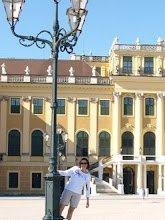Welcome to the world of Toni Dove’s digital art work, where in her own words on Here.org “is a Bermuda triangle between games, theater
and film”.
As touched on in the opening, Toni Dove’s recipe of art intertwines theater performance, computer graphics, video projection and interactive media to include motion sensing and sound, and in some cases robotics. Taken from the Felix interview, “…I've always been interested in mixing high tech and low tech and being able to create some kind of collage where you can develop an aesthetic out of a bunch of technologies.”
In her work, Toni aims to escape linear story-telling by enabling the viewer to change the story progression, as Women, Art and Technology explains, “she (Toni Dove) is interested in an immersive experience that triggers feelings of engagement that can be used to intensify the narrative experience.” Taken from the Felix interview, “…the idea of immersion in a narrative space. The sensation of walking around in a movie... And the other aspect, was a certain kind of virtual illusion that results when a physical action produces a response in video and audio. And that can be a powerful and actually sensual experience.”
Throughout her pieces, Toni Dove touches on psychological, social and economic themes from intimacy to consumerism. Her ideas are often born from digital advertising and/or watching movies.
To recap some of Toni Dove’s works:
In Ghosts, Mari Kimura and Toni Dove control screen movements via robotic beings. Using multiple backdrops, the three-dimensional piece becomes a theatric event with music, singing and dialog between the virtual ghost and the two creators of the piece.
In Spectropia (2001), the performance opened with digitalized commentators Sally and William, who summarize the story. In the year 2099, Spectropia has set up a lab to locate her father lost in time while searching for inheritance. In scanning old garbage, Spectropia was able to construct virtual realities to piece together past events. One example, Spectropia scans found cloth fibers resulting in Sally, the bubble dancer, virtual resurrection from the 1930s. When Spectropia’s equipment short-circuits, Spectropia is transported in back in time and into the body of a female detective. From the technical aspect, Toni Dove and her co-performer, Luke Dubois, are puppeteering the unfolding events.
In Artificial Changelings (1995-2000), the viewer dictated the sequence of events by where they are located within different floor pad zones in front of a projected screen. The motion of the viewer impacted character behavior. The story line was a romantic thriller revolving around a 19th century Paris kleptomaniac who has a distant connection to a future encryption hacker. For a sampling of interactivity, place cursor over images: http://www.tonidove.com/interface.html
Casual Workers, Hallucinations and Appropriate Ghosts (1994) was a video installation piece commenting on troubling themes within human intimacy. The work was positioned following a string of adult video retailers in Times Square. Outside an empty theater, video and sound emanated from glass cases along the strip.
Archeology of a Mother Tongue (1993), collaboration with Michael Mackenzie, was a murder mystery with computer graphics, laser disk video and interactive sound. The viewer looked through a camera which enabled the viewer to look within the virtual space; as well as, to seemingly touch objects within the screen using a virtual glove. The viewer becomes the coroner character in the story line as a murder investigation unfolds. The book, Immersed in Technology, explains that the "questions raised in this piece isn’t only where do I come from but also am I human or machine, alive or dead?"
The Blessed Abyss - A Tale of Unmanageable Ecstasies (1992) used 15 slide projectors, pre-recorded sound and video projection onto three-dimensional backdrops. The statement Toni Dove wanted to convey in this piece was how society dictates our passions which lead to excesses
and perversity.
Toni has served on many art boards and is a multiple grant and award recipient. Her piece, Spectropia, is currently on tour. She lives and works out of New York but has had performances in Europe and Canada; as well. Her pieces have been displayed in print, radio and on TV. Her comment, from Felix, on some traditional mediums “the whole notion of photography and film as a documentary medium is toast, it's finished. It's become a completely plastic and manipulatable arena. Which is what I always wanted to do with it anyway. So it suits me quite nicely.”
References
Artist website:http://www.tonidove.com/
Interview:
http://www.e-felix.org/issue4/electronic.html
Biography info:
http://www.here.org/who/artists/ghosts/#tonidove-statement
Immersed in Technology, Art and Virtual Environments, edited by Mary Anne Moser and Douglas MacLeod for the Banff Centre for the Arts, The MIT Press, Cambridge, Massachusetts and London, England, © 1996
Women, Art and Technology, edited by Judy Malloy, The MIT Press, Cambridge, Massachusetts and London, England, © 2003










